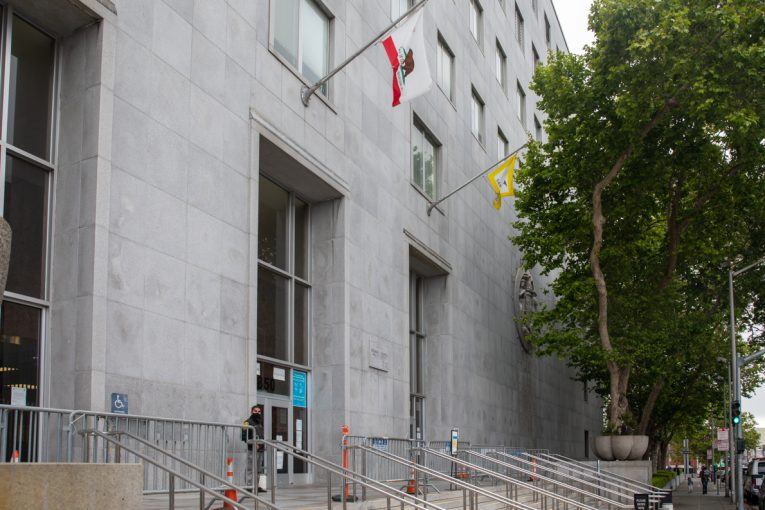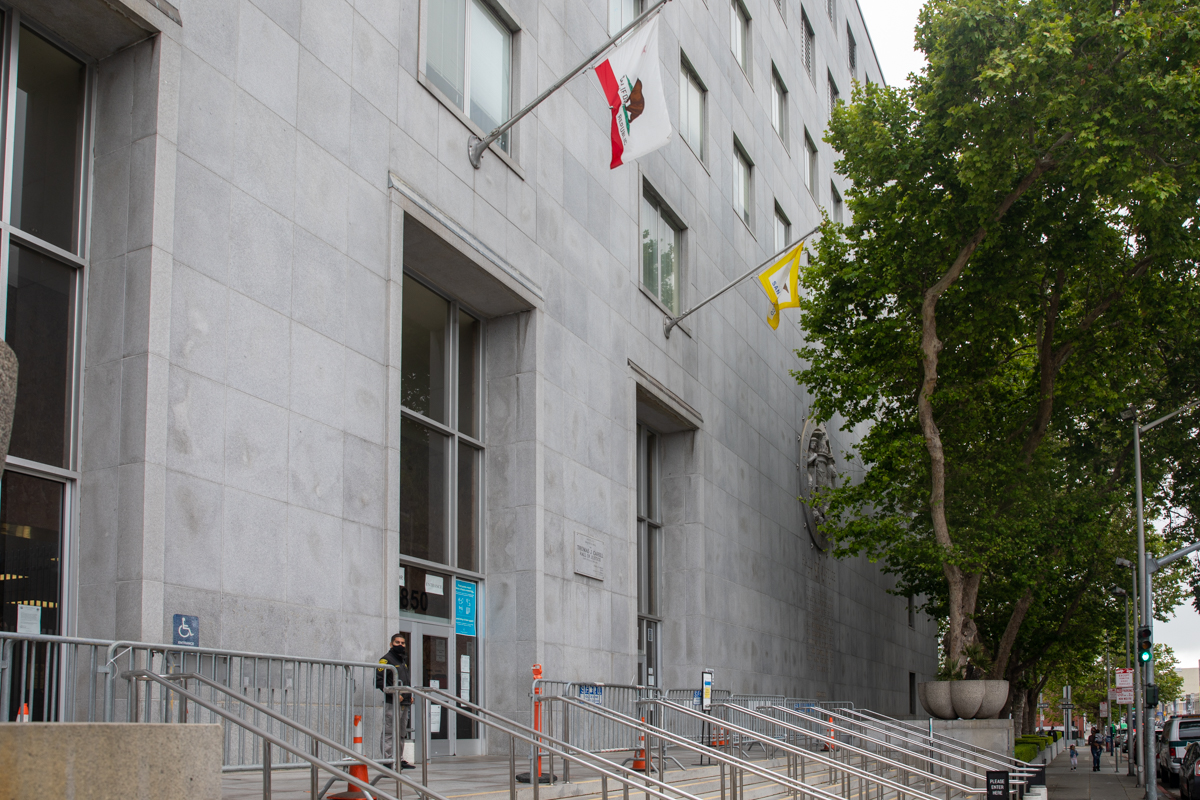

By Kenneth Truong
SAN FRANCISCO, CA – The jury was still without a verdict Friday in the trial—it resumes deliberations Monday—in San Francisco County Superior Court in the trial of Terrance Stangel, the first SF Police Dept. officer to ever face criminal trial for on-duty actions.
Stangel is charged with four felonies for excessive force in the beating in 2019 of Dacari Spiers, including battery with serious bodily injury, assault with a deadly weapon, assault with force likely to cause great bodily injury, and assault under color of authority.
The 12-person jury began deliberating last Tuesday morning—Stangel could be sentenced to as many as seven years in prison if convicted.
As for Spiers, he settled a civil rights case for $700,000 this past week, as approved by the San Francisco Board of Supervisors.
SF Assistant District Attorney Rebecca Young closed her case by telling jurors that Stangel not only ignored his training, but failed to recognize Spiers’ humanity by repeatedly ignoring the unarmed Black  man’s questions and pleas.
man’s questions and pleas.
Stangel Defense Attorney Nicole Pifari began her closing argument by noting that Stangel is not a robot, but a human with emotions. Stangel has a family, is brave, and honest, Pifari said, noting that Stangel works all day standing by to “help” the public.
She said Stangel “made the best decision he could at the moment” when faced with a chaotic situation Oct. 6, 2019, when he beat Spiers—severely injuring him—in a confusing incident in San Francisco.
This is a criminal trial where the jury could convict Stangel of violent felonies. Spiers, the victim in this incident, was never charged with anything. Pifari asserts that Spiers was the aggressor when he was confronted by the police and created a violent situation.
Young repeatedly charged that Stangel and his partner failed to follow police training even before getting out of the car on the night of the incident.
Stangel “recklessly disregarded his extensive training,” Young said, arguing “They’re the ones who blew up, they’re the ones who lost control.”
“[Spiers] is, yes, resistant. But he is never assaultive,” Young said in her closing. SFPD’s use of force rules only allows officers to use their batons against “an assaultive subject who is actively resisting and poses a threat to the safety of officers or others,” Young noted.
Young argued that even if officers were justified in using batons initially, “nothing justifies” the later strikes—Spiers was hit eight times—while Spiers was on the ground.
Noting the “awesome power” police have, Young said “it’s common knowledge that tall, dark Black men are often associated with menace.”
Stangel and his partner did not “recognize Dacari Spiers as a human being who deserved acknowledgement” or a response, Young told jurors.
Young showed jurors video of Spiers’ then-girlfriend pulling her arm away from another officer, similar to what Spiers did and officer did nothing like Stangel and Martinez did to Spiers.
Stangel arrived at the scene when his partner, Officer Cuahtemoc Martinez, was allegedly being shoved around and getting battered by Spiers.
A lot of evidence was presented at trial. However, very little was focused on what Stangel witnessed. The jurors heard Stangel’s testimony. But most of the evidence was presented through other witnesses.
As Pifari continued to pace around the courtroom, she asserted the prosecution’s case was terrible and not supported by evidence. The district attorney created an “alternate reality” to bring this case to trial, Pifari argued.
Stangel never saw the alleged domestic violence, although what he thought was a crime was really just the victim comforting his girlfriend who had her wallet stolen, according to the prosecution.
But Pifari stated the prosecution has been dishonest since the start of the case, which was met with sarcastic laughter by several members of the audience.
The prosecution created a “false, made-up reality,” said the defense attorney, and insisted both Spiers and then-girlfriend, Breonna Richards, have zero credibility. The couple lied to the jurors about what occurred before the incident. This is why the prosecution called the 911 callers as witnesses.
Defense eventually presented examples where lies were given on the stand: How Spiers “draped his arms over the shoulders” to look like a loving couple, and how Spiers testified that they were kissing and waddling over to the car.
Pifari explained that the third-party witnesses lied to the jury and it was “dishonest and disgusting” because their testimony ran contrary to their statements given 48 hours after the incident.
Pifari shouted during her closing that Spiers kept saying “you thought you got away b***h” as he dragged her and lifted her above the ground by the neck—pressing Richards’ body against a truck. When the police arrived, the prosecution argued that the witnesses misperceived the situation because of the poor lighting and a tree blocking the view.
Witnesses allegedly said they heard Spiers say, “Give me my cell phone, b***h!” and “I got you now b***h,” and described a woman being lifted, put in a headlock, and dragged down the street by the arm.
As Spiers’ attorney Curtis Briggs told the Vanguard, “(Stangel) was dispatched based on (the 911 call), Sergeant O’Connor had interviewed them and they got a statement from them. And this statement in Stangel’s eyes is exculpatory… Because their premise is if Stangel was responding to a DV in progress, he has a right to jump out and start beating on people.”
But Spiers said he was standing close to his girlfriend, arm in arm, kissing and hugging her to calm her down when two women walked by and started staring at him.
He said that they had never had any physical altercations and denied that they were involved in one that night.
In a separate room, the girlfriend was questioned. She said they were wine tasting. She described herself as upset and left the garage thinking that one of Spiers’ little brother’s friends stole her wallet. They walked out of the garage to take the bus to leave, and she described herself as emotional because she had been drinking.
Spiers did not want her to leave and started to calm her down. The girlfriend said they were not involved in a physical altercation and in one report said that she “would never let a man hit her.”
The police described the girlfriend as having no visible injuries.
But, as Stangel’s defense attorney maintained to the jury, the district attorney is biased and this was a politically motivated prosecution.
Defense Attorney Pifari said Spiers was angry and out of control with his emotions and in a rage, and Spiers’ testimony has no credibility in court.
She told the jury Spiers “seems like he’s a man that has little to no control of his emotions,” and gave multiple examples of Spiers’ past battery and assault convictions, including his domestic violence charges. “The cycle of violence continues,” Pifari added.
Pifari insisted Stangel arrived at the scene with Martinez and Spiers already struggling on the ground, arguing the situation could not be controlled with hands alone and the baton was necessary.
Stangel, according to the officer’s defense attorney, was using appropriate force when he used the baton on Spiers’ legs to neutralize the threat.
And Attorney Pifari added that Stangel believed that he or Martinez was in immediate danger of serious bodily injury.
Pifari charged Spiers had lied about his weight, how Richards was not mad at him, and that he didn’t hear the officers saying anything. Pifari explained that she impeached Spiers on his testimony using prior statements. Spiers was resisting a lawful detention and he was not oblivious to the situation.
The girlfriend, said the officer’s defense, had a motive to protect her boyfriend, noting at trial that she was unable to answer questions on 69 occasions… stating that she did not remember or recall, and that she is a victim in a domestic violence case.
As Pifari closed, she recapped that officers have the benefit of the doubt. And that the jury is not there to decide whether the police are good or bad.
According to news report, the case has widened an already deep chasm of trust between the district attorney’s office and police department. Claims that the DA’s office withheld evidence from police in the Stangel case could undo a 2019 agreement that makes the DA’s office lead investigator for police use-of-force incidents.
Reporting notes that SF Police Chief Bill Scott has moved to terminate the agreement and asked California Attorney General Rob Bonta’s office for guidance on finding alternatives for independent investigations of officer misconduct.
SF District Attorney Chesea Boudin has promised his office will continue to investigate police shootings, excessive force and other police misconduct, even if the police department refuses to cooperate with those investigations.
